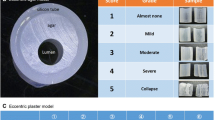Abstract
Heavy calcification is one of the factors that hinder the success of coronary angioplasty, and a cutting balloon is used for such lesions. This study aimed to explore the optimal method of dilation of highly calcified lesions using a cutting balloon. Calcification models were developed from patient computed tomography and intravascular ultrasound data, and were constructed using three-dimensional printers. The lesions were dilated using a Wolverine™ cutting balloon and NC Emerge™ noncompliant balloon catheter, and the success rate of dilation and maximum dilation pressure were compared. The maximum first principal stresses in calcified lesions were also evaluated by computer simulation using the finite element method. In the bench test, the dilation success rate of the Wolverine™ cutting balloon was higher and the maximum dilation pressure required was lower (p < 0.01 in all analyses), compared with that of the NC Emerge™ balloon catheter. Finite element analysis showed that the cutting blade increased the maximum first principal stresses in calcified lesions, thus allowing for successful dilation at low pressures. The highest stress was obtained when the cutting blade was positioned at the thinnest part of the calcification. The cutting balloon allows for efficient calcification expansion by concentrating the stresses in the blade. When a cutting balloon is used, if the calcified lesion cannot be expanded in a single dilation, dilation success may be achieved after the balloon is rotated and the position of the blade is changed.





Similar content being viewed by others
Abbreviations
- PCI:
-
Percutaneous coronary intervention
- 3D:
-
Three-dimensional
- IVUS:
-
Intravascular ultrasound
- CT:
-
Computed tomography
References
Kobayashi Y, Okura H, Kume T, Yamada R, Kobayashi Y, Fukuhara K, et al. Impact of target lesion coronary calcification on stent expansion—an optical coherence tomography study. Circ J. 2014;78:2209–14. https://doi.org/10.1253/circj.CJ-14-0108.
Iakovou I, Schmidt T, Bonizzoni E, Ge L, Sangiorgi GM, Stankovic G, et al. Incidence, predictors and outcome of thrombosis after succesful implantation of drug-eluting stents. J Am Med Assoc. 2005;293:2126–30. https://doi.org/10.1001/jama.293.17.2126.
Shavadia JS, Vo MN, Bainey KR. Challenges with severe coronary artery calcification in percutaneous coronary intervention: a narrative review of therapeutic options. Can J Cardiol. 2018;34:1564–72. https://doi.org/10.1016/j.cjca.2018.07.482.
Amemiya K, Yamamoto MH, Maehara A, Oyama Y, Igawa W, Ono M, et al. Effect of cutting balloon after rotational atherectomy in severely calcified coronary artery lesions as assessed by optical coherence tomography. Catheter Cardiovasc Interv. 2019;94:936–44. https://doi.org/10.1002/ccd.28278.
Asakura Y, Furukawa Y, Ishikawa S, Asakura K, Sueyoshi K, Sakamoto M, et al. Successful predilation of a resistant, heavily calcified lesion with cutting balloon for coronary stenting: a case report. Cathet Cardiovasc Diagn. 1998;44:420–2. https://doi.org/10.1002/(SICI)1097-0304(199808)44:4%3c420::AID-CCD13%3e3.0.CO;2-M.
Tang Z, Bai J, Su SP, Wang Y, Liu MH, Bai QC, et al. Cutting-balloon angioplasty before drug-eluting stent implantation for the treatment of severely calcified coronary lesions. J Geriatr Cardiol. 2014;11:44–9. https://doi.org/10.3969/j.issn.1671-5411.2014.01.012.
Okura H, Hayase M, Shimodozono S, Kobayashi T, Sano K, Matsushita T, et al. Mechanisms of acute lumen gain following cutting balloon angioplasty in calcified and noncalcified lesions: an intravascular ultrasound study. Catheter Cardiovasc Interv. 2002;57:429–36. https://doi.org/10.1002/ccd.10344.
Kawase Y, Saito N, Watanabe S, Bao B, Yamamoto E, Watanabe H, et al. Utility of a scoring balloon for a severely calcified lesion: bench test and finite element analysis. Cardiovasc Interv Ther. 2014;29:134–9. https://doi.org/10.1007/s12928-013-0232-6.
Tack P, Victor J, Gemmel P, Annemans L. 3D-printing techniques in a medical setting: a systematic literature review. Biomed Eng Online. 2016;15:1–21. https://doi.org/10.1186/s12938-016-0236-4.
Veress AI, Vince DG, Anderson PM, Cornhill JF, Herderick EE, Klingensmith JD, et al. Vascular mechanics of the coronary artery. Z Kardiol. 2000;89:92–100. https://doi.org/10.1007/s003920070106.
Walraevens J, Willaert B, De Win G, Ranftl A, De Schutter J, Sloten J Vander. Correlation between compression, tensile and tearing tests on healthy and calcified aortic tissues. Med Eng Phys 2008;30:1098–1104. https://doi.org/10.1016/j.medengphy.2008.01.006.
Acknowledgements
We would like to thank Mr. Hideo Yamada (Free Radical Inc.) and Mr. Kosei Fujimoto (Department of Biomechanics, Institute for Frontier Medical Sciences, Kyoto University) for their guidance on the structural analysis of this study. We would like to express our deepest gratitude to them. We would like to thank Editage (www.editage.com) for English language editing.
Funding
The balloons used in the experiment were provided by Boston Scientific.
Author information
Authors and Affiliations
Corresponding author
Ethics declarations
Conflict of interest
The authors have no conflicts of interest to declare.
Additional information
Publisher's Note
Springer Nature remains neutral with regard to jurisdictional claims in published maps and institutional affiliations.
Rights and permissions
About this article
Cite this article
Song, X., Adachi, T., Kawase, Y. et al. Efficacy of the Wolverine cutting balloon on a circumferential calcified coronary lesion: Bench test using a three-dimensional printer and computer simulation with the finite element method . Cardiovasc Interv and Ther 37, 78–88 (2022). https://doi.org/10.1007/s12928-020-00739-2
Received:
Accepted:
Published:
Issue Date:
DOI: https://doi.org/10.1007/s12928-020-00739-2




